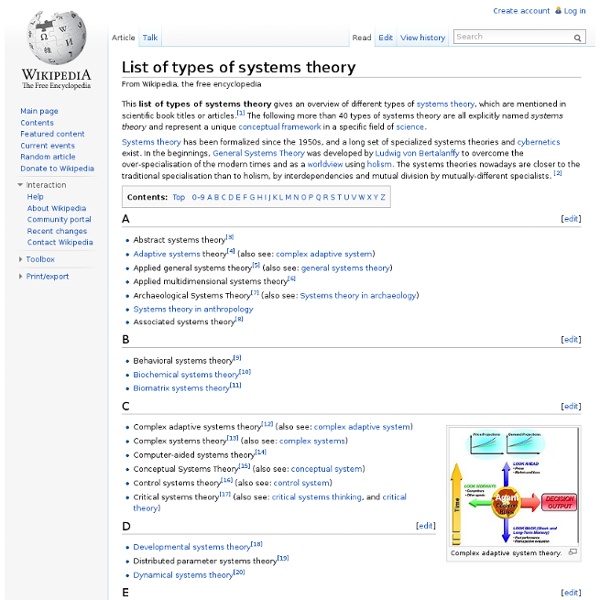



Glossary of systems theory A glossary of terms as relating to systems theory.[1] A[edit] B[edit] C[edit] Cascading failure: failure in a system of interconnected parts, where the service provided depends on the operation of a preceding part, and the failure of a preceding part can trigger the failure of successive parts.Closed system: a system which can exchange energy (as heat or work), but not matter, with its surroundings.Complexity: A systemic characteristic that stands for a large number of densely connected parts and multiple levels of embeddedness and entanglement. D[edit] Development: The process of liberating a system from its previous set of limiting conditions. E[edit] F[edit] H[edit] I[edit] Isolated system: A system in which the total energy-mass is conserved without any external exchange happening. L[edit] Lowerarchy: A specific type of hierarchy involving a ‘bottom up’ arrangement of entities such that the few are influenced by the many. M[edit] O[edit] Open System Model (basics) P[edit] R[edit] S[edit] W[edit]
Generation FAB by Matthew Gardiner on Prezi Negative Thinking A CEO calls her staff into the conference room on the eve of the launch of a major new initiative. They file in and take their seats around the table. She calls the meeting to attention and begins, “I have bad news. The project has failed spectacularly. What went wrong?” The team is perplexed: What?! I know it seems strange and maybe even counterproductive to demand that employees think negatively instead of optimistically, but in business circles today, everyone from startups to Fortune 500 companies and the Harvard Business Review are doing this exact exercise. The technique that the CEO above was using was designed by psychologist Gary Klein. Stocklite/Shutterstock In fact, I think more companies need a Chief Dissent Officer, someone to shoot down the bad ideas that our blind spots and naive optimism too often obscure. The practice goes back much further than just psychology though. A writer like Seneca would begin by reviewing or rehearsing his plans, say, to take a trip.
Invention (technique) Un article de Wikipédia, l'encyclopédie libre. Sur les autres projets Wikimedia : invention, sur le Wiktionnaireinventer, sur le Wiktionnaire Une invention est une méthode, une technique, un moyen nouveau par lequel il est possible de résoudre un problème pratique donné. Une invention est en général reconnue par la délivrance d'un brevet d'invention. - inventer c’est créer un nouveau produit ou dispositif, un nouveau procédé ou méthode d’obtention d’un résultat inconnu jusque-là ; - innover diffère d’inventer au sens où tous les éléments constitutifs sont non seulement connus, mais de plus le résultat à obtenir est totalement prévisible. Pour vous fixer les idées, le fait d’ajouter un chrono-contacteur à une cafetière qui mettra cette dernière en fonctionnement à l’heure que vous aurez déterminée à l’avance tout en vous servant de réveil matin n’est en aucun cas une invention mais une innovation. L'invention revêt toujours un caractère technique.
Home Pirate3D Buccaneer Pirate3D lance Buccaneer, l'imprimante 3D grand public à assembler pour 347 dollars. Bien que l'impression 3D tende à se démocratiser, les imprimantes 3D restent tout de même relativement peu accessibles pour la plupart des intéressés. Pirate3D, une entreprise basée à Singapour, ambitionne d'ouvrir la technologie au plus grand public, rivalisant ainsi avec la Cube et la Replicator de Makerbot, respectivement vendues 1299 dollars et 1956 dollars. L'imprimante, fabriquée en acier estampé, est à assembler soi-même. Ultra minimaliste et compacte, elle sera facile à placer sur 25 x 25 cm d'un bureau, car ses dimensions sont des plus raisonnables : 15 x 10 x 12 cm. Sans bouton, la Buccaneer se connecte aux périphériques réseau en Wi-Fi. Toutes les explications sont illustrées dans une vidéo : Pour illustrer les caractéristiques techniques de l'engin, Pirates3D établit un comparatif avec la Replicator 2, sa principale concurrente et leader du marché.
Brain Structures and Their Functions The nervous system is your body's decision and communication center. The central nervous system (CNS) is made of the brain and the spinal cord and the peripheral nervous system (PNS) is made of nerves. Together they control every part of your daily life, from breathing and blinking to helping you memorize facts for a test. The brain is made of three main parts: the forebrain, midbrain, and hindbrain. The Cerebrum: The cerebrum or cortex is the largest part of the human brain, associated with higher brain function such as thought and action. What do each of these lobes do? Frontal Lobe- associated with reasoning, planning, parts of speech, movement, emotions, and problem solving Parietal Lobe- associated with movement, orientation, recognition, perception of stimuli Occipital Lobe- associated with visual processing Temporal Lobe- associated with perception and recognition of auditory stimuli, memory, and speech Note that the cerebral cortex is highly wrinkled.
Pensée latérale Un article de Wikipédia, l'encyclopédie libre. La pensée latérale est un ensemble de techniques théorisées par Edward de Bono, Docteur maltais en médecine et en philosophie, Master en psychologie et physiologie et auteur de plusieurs livres sur la créativité. Cet ensemble de méthodes de résolution de problème consiste à approcher les problèmes sous plusieurs angles au lieu de se concentrer sur une approche unique[1]. Définition et application[modifier | modifier le code] La pensée latérale se définit par opposition à la pensée verticale, qui est la pensée classique, caractérisée par la continuité entre les étapes et la validation pas à pas des hypothèses et de chaque résultat intermédiaire. En pensée verticale, une idée dont l'applicabilité n'est pas validée est rejetée et n'est plus considérée dans la suite du processus. Ces discontinuités peuvent être provoquées de plusieurs manières (Cf. Techniques de pensée latérale[modifier | modifier le code] Exemple 1[modifier | modifier le code]